From The CRPG Addict
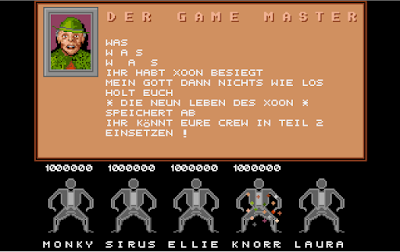 |
| The Game Master gives us some useless experience points at the end of Dark Stone Ritual. |
Difficulty: Easy (2/5)
Final Rating: (to come later)
Ranking at time of posting: (to come later)
Summary:
 |
| Unlocking the “Swimming” ability was the last obstacle to open-world exploration. |
 |
| A bit of the final game map. |
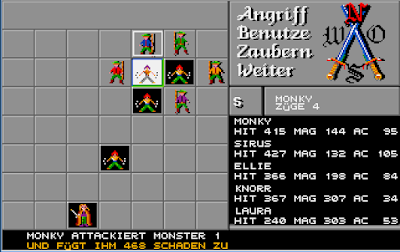 |
| “Strategic” combat lets you position characters and aim your attacks at a particular foe. |
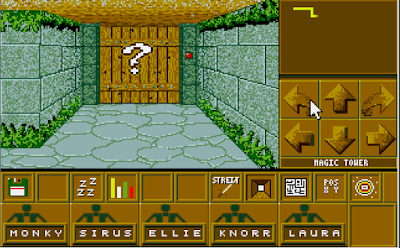 |
| Exploring a dungeon. An encounter lies ahead. |
A few things that I otherwise didn’t get a chance to cover along the way:
- An arena appears in two locations in the overworld. When you enter, you can tell the game how many enemies you want to face and at what levels. I didn’t really experiment with it, but it’s an alternate source of experience if you somehow need it. The concept is of course lifted from Might and Magic.
- In what I think is an original element, a few dungeon entrances (including the last) required entering a pattern of green, red, and blue gems on some kind of plate. You have to find the correct patterns in other places.
 |
| Arranging stones on the door of the final dungeon. |
- There was one door with a combination lock for which I never found the combination. Fortunately, reader Buck reached the same point before me and figured out the answer from the game’s code.
- While I’m on unsolvable puzzles, at least three times I was asked to choose from among five symbols. Choosing the wrong one killed the selected character. A tavern tale had warned me that choosing the right symbol would kill the selected character, too, if it was a man. I had to figure out the answers from save-scumming. I have no idea where I was supposed to get them.
 |
| Do those symbols mean something? |
- There’s a useful “return to entrance” button while in dungeons. If your selected character has a high enough “Pathfinding” skill, you’ll return swiftly to the exit stairs. I wish every game had this.
- There are fountains all over the world map that raise attributes, hit points, resistances, and spell points, but no combat is tough enough to require them. The final island has about six.
 |
| Okay, I guess they’re not so much “fountains” as “offers of wine.” But they’re direct analogues to Might and Magic’s fountains. |
The game culminated on a small compound on a northern island. A guardian demanded a password. What she really wanted was a pass phrase, compiled from five words given by residents in little huts in exchange for certain rare stones. The stones, in turn, came from other residents to whom I brought “stone plates” found scattered about the island. The full phrase, for posterity’s sake, is BRENUM BRANUM KANUM LUZE LEI. (Thanks again to Buck for helping with this.)
 |
| Does that look like a “word” to you? |
This allowed me access to Xoon’s dungeon, which is called “Dark Stone Verlies.” I verified later that the “Caveportal” spell will take you there if you just know the name, meaning that a second-time player could skip a lot of stuff and just warp to the endgame.
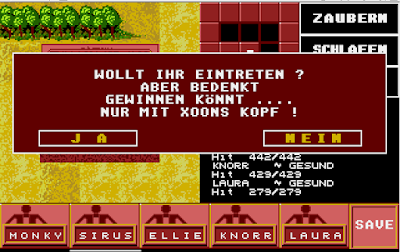 |
| The game reminds me that I must emerge with Xoon’s head. |
The dungeon is the only one that has multiple levels (three) and the only one that doesn’t remember your progress if you leave and return. There was only one combat, early in the first level, with a guardian of Xoon’s named Morok (I’m sure that name was in previous Motelsoft titles). It was one of the battles that I had to fight in “strategic” mode to win. In “strategic” mode, you can position your characters around individual enemies and target them, ensuring that you can reduce their numbers faster. (“Quick” combat targets enemies randomly.) You also get more attacks per round. Between the advantages of strategic combat and the “Full Heal” spell that I’d recently acquired, the battle was quite easy.
 |
| “Quick” combat was the wrong choice for this final battle. |
The dungeon’s second level is one of the largest in the game, full of secret doors, teleporters, traps, and a bunch of pits to jump. Eventually, you find your way to the third level and the mystifyingly anti-climactic encounter with Xoon, if it is Xoon. I’m not sure I haven’t mistranslated or misunderstood something. The climax begins with a black-faced man, flanked by two women, saying: “Ihr wollt meinen kopf, ich weiss. Nun gut wenn ihr unbedingt haben müsst. Ha ha ha. Dann sollt ihr Xoons kopf auch bekommen.”
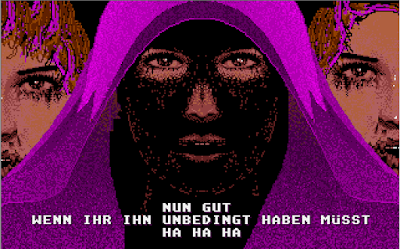 |
| Nice shoepolish, Jolson. |
The scene then dissolves away, the party is teleported back near to the entrance, and in their inventory is Xoon’s head.
I translate his text as, “You want my head, I know. Well, if you have to have it, you should also get Xoon’s head,” suggesting that he himself is not Xoon. It’s worth noting that the game uses the same portrait for the master of the Dark Stone sect earlier in the game (although it also re-uses a lot of portraits). I wondered if joining the Dark Stone sect and finding the Dark Stone itself are optional, and that doing so leads to an “easy” ending where the master kills Xoon for you. This is partly suggested by an item in the game’s hint file that says, “If you have the Dark Stone, the rest is a children’s game!” I tested this theory by loading a saved game from before I had the Dark Stone and using “Caveportal” to go directly to the dungeon. (I had to buff with fountains to win the first-level battle.) But no, the same thing happens even if you don’t have the Dark Stone.
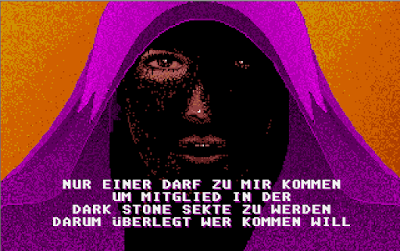 |
| A previous appearance by the same character. |
Whatever the case, the game ends when you return Xoon’s head to the Game Master back in the dungeon Glorys. The Game master expresses astonishment that you managed to kill Xoon, who was supposed to have nine lives, and then suggests you save your game for Part 2.
- 1 point for the game world. Ritual comes with no backstory, and while the continent and its features are visually interesting, there’s nothing in the way of lore or culture to be found here.
- 3 points for character creation and development. Without the separate character editor, the game unfortunately has no creation process. But the characters are quite well detailed in attributes and skills, and development is satisfying enough for a few levels, until the game becomes too easy. In the end, the character sheet is more complex than necessary given the limited game content.
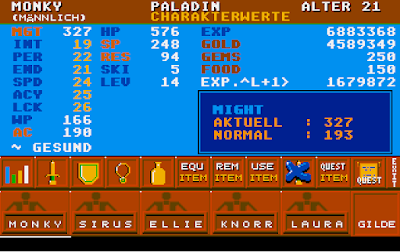 |
| My final paladin character. |
- 1 point for NPC interaction. The little dudes in huts are more like “encounters” or “quests” than NPCs.
- 3 points for encounter and foes. Monsters are probably the weakest part of the game. Most of them are unnamed. They’re distinguished only icon and number of hit points. Because they lack significant special attacks or defenses, there’s little need to explore the game’s variety of spells. Non-combat encounters are a bit more interesting, with a couple of challenging puzzles, although nothing that approaches Dungeon Master in complexity. I liked the option to search for enemies in already-cleared towns and caves.
- 3 points for magic and combat. I give some credit for the two combat modes, and “strategic” combat offers some real positioning tactics. I didn’t bother to explore more than half a dozen magic spells, particularly since there are no mass-damage spells and the individual-damage spells do less damage than a physical attack.
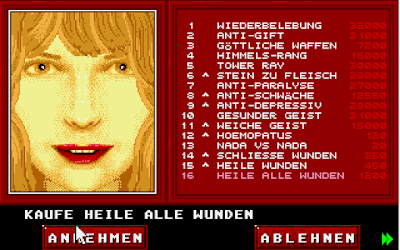 |
| Buying spells in the last town. I never found out what half of these spells do and never cast half of the rest. |
- 5 points for equipment. Ritual adopted Might and Magic‘s complexity with inventory, where items can have multiple bonuses and features and there are usable items to sub for many spells. Again, though, combat was too easy to bother exploring most of these features, and I largely decided which weapons and armor to keep based on cost.
 |
| This helm effectively increases my level by 1. |
- 3 points for economy. There are lots of things to buy–training, skill acquisition and building, weapons and armor, and healing among them. It’s just too easy to acquire enough money for the entire game within the first few hours.
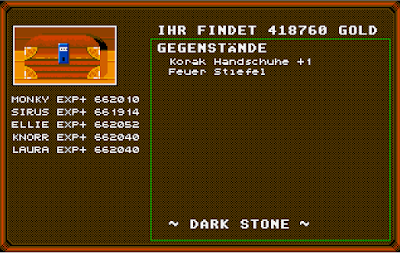 |
| The game provides absurd amounts of gold at regular intervals. |
- 3 points for quests. The game has a main quest, if a little light, and a few side quests that impart extra valuables and skills.
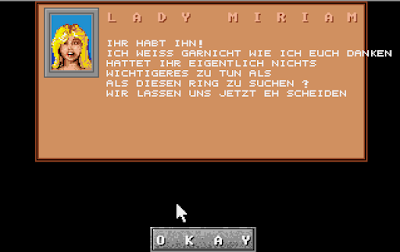 |
| The party solves a side quest to return a ring, only to find that the quest giver was divorced in the meantime. |
- 2 points for graphics, sound, and interface. The graphics are fine, but there is no sound at all. The mouse part of the interface works well, but unfortunately the mouse part is the only part, which I don’t find remotely forgivable.
- 3 points for gameplay. It has a little nonlinearity at the beginning, and the total number of hours was good for its content. Unfortunately, it was too easy and has no replayability.
That gives us a final score of 27. Motelsoft is making better, more complex games in 1992, and letting itself be influenced by the right titles from bigger developers, but it still lacks a certain sense of balance and polish. Despite the promised sequel, it doesn’t look like there was ever a Magic Tower II. We’ll see them again this year with Arcana unless I happen to pick up Projekt Terra (1991) or Sandor II (1991) on my “old” list first.
Let’s see if I can finish up Star Control II this week, too. If not, the next 1992 game is a Macintosh title called Darkwood. Looking at a couple of screenshots, I’m pretty sure I’ve played this before. If it’s the one I’m thinking of, it won’t be more than a single entry.
Original URL: http://crpgaddict.blogspot.com/2019/05/dark-stone-ritual-won-with-summary-and.html
